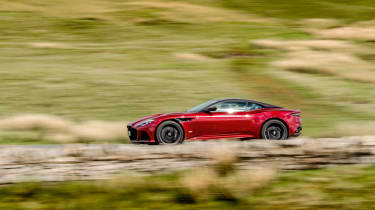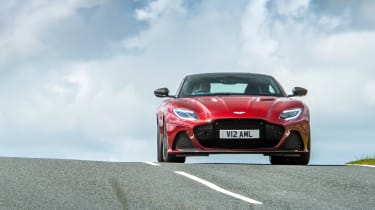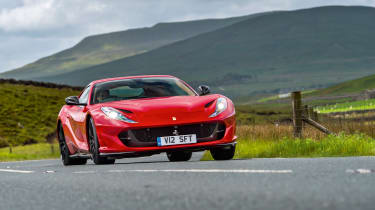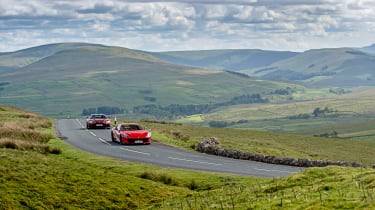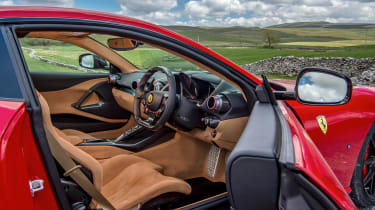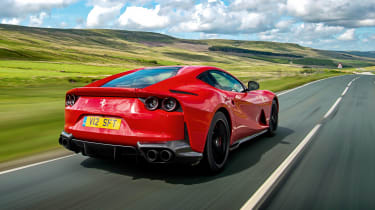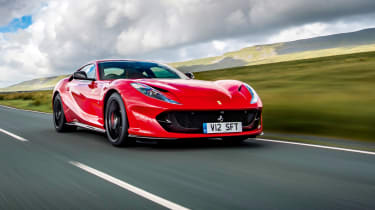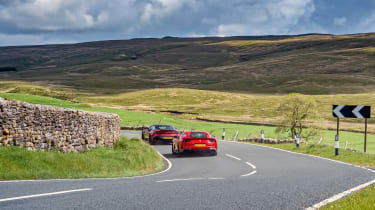Aston Martin DBS Superleggera v Ferrari 812 Superfast
Each with a 700bhp-plus V12, the Aston Martin DBS Superleggera and Ferrari 812 Superfast are the ultimate GTs from their respective marques. Which best nails its brief?
Thirty seconds or so is all it takes for the Ferrari 812 Superfast to decimate everything you think you know about front-engined GT cars. Notions of giant, effortless strides that swallow time and distance, of engines that feel imperious and have such vast reserves that even rapid progress seems simple and devoid of the stresses and strains of lesser machines, of deliberate handling where the masses are obvious but wonderfully managed with rippling muscularity. GT cars as almost tidal, unstoppable forces.
That’s not the 812 Superfast’s style. A long-legged gait is replaced by a frenzy of action so extreme it feels almost chaotic, the engine is savagely sharp and doesn’t so much swallow journeys whole as attack them like a swarm of piranhas ripping at a carcass, and the cultured heavyweight chassis with calm, measured dynamics makes way for extreme agility and a manic, hyper-alert personality. Forget tidal. At times it can feel like you’ve been caught in the thrashing, disorientating, furious break of a 100-foot wave as it hits a rocky coastline.
> New Aston Martin DBS Superleggera review – a mighty V12 GT with supercar speed
So settle into the Aston Martin DBS Superleggera in a half-euphoric, half-terrified daze and – for what feels like the first time since you started the Ferrari’s 789bhp V12 – take a breath. Some of the detailing is perhaps a shade fussy, but the architecture – a dash that seems to reach out and envelop you, high-shoulders and an imposing central tunnel that stretches back towards the transaxle – is somehow reassuring. Then you press the smooth, cool glass starter button and the 5.2-litre twin-turbocharged V12 starts with a yobbish (but heart-warming) howl that dissipates to a softly bassy, powerful refrain.
A press of a little toggle switch marked ‘S’ on the right-hand spoke of the steering wheel selects Sport or Sport+ mode and lets the V12 find its voice, but still the note is deeper and calmer than the digitally sharpened Ferrari’s V12. You could guess their respective traits before even turning a wheel, I suspect. The Aston sounds like it’s superheated with torque, whereas the Ferrari seems to be spitting highly strung power directly out of its exhausts. From this disparate starting point the cars only diverge further. Picking a winner here isn’t really about combing meticulously through the dynamics of these two monsters. Ferrari and Aston Martin have thrown their completely different philosophies at the same problem. So which one do you buy into?
I’m sure it’s a dilemma we’d all love to face. And although the performance, mechanical layout and prices barely begin to tell the story, it’s worth delving deep just to marvel at what Ferrari and Aston Martin are offering. Let’s start with the Aston. ‘Superleggera’ might not be literal in this case, but even with 1770kg of aluminium chassis and carbonfibre bodywork to haul the V12 undoubtedly has the minerals. It produces 715bhp at 6500rpm, backed up by a faintly ludicrous 664lb ft from 1800 to 5000rpm. Hook all of that up and you’ll crack 0-100mph in 6.4sec. It also has adjustable dampers (GT, Sport and Sport+ modes) and powertrain modes (ditto), a two-stage stability control system and the familiar eight-speed automatic transaxle. Oh, and a sinfully beautiful body that makes the £225,000 starting price sound wholly natural.
So the Aston is beautiful, brutally powerful, can allegedly reach 211mph and marries material and electronic technology to the evocative GT formula with effortless grace. Yet next to the Ferrari it’s almost demure. These numbers are so absurd they’re actually a joy to type. The Superfast’s 6.5-litre atmospheric V12 revs to 8900rpm. Just 400rpm shy of that limiter it produces 789bhp – that’s 121.5bhp per litre – and this 1630kg front-engined, rear-drive car will get to 100mph in under six seconds. It too has a transaxle, but this time a seven-speed dual-clutch ’box. I don’t know for sure, but my guess is the shift time is somewhere in the quantum realm. Plus, there’s new electric power steering with Virtual Short Wheelbase 2.0 (or rear-wheel steering as everyone else calls it), Side Slip Control 5.0, magnetorheological dampers, five driving modes (Wet, Sport, Race, plus settings for switching the traction and stability controls off), active aerodynamics and hundreds of other acronyms, including my favourite, FPO (Ferrari Power Oversteer). The 812 Superfast looks like a GT car in proportion and configuration, but in detail it’s purebred supercar. It costs from £263k, but this one – like most customer cars – is a shade over £350k.
However, today isn’t about such earthly concerns. I’ve just been well and truly Ferrari’d and now the Aston Martin’s calmer V12 is trying to dissipate the tension in my hands, arms and shoulders. I’ve already mentioned the low-set driving position and the sculpted monument of the dashboard, which combine to make you feel cocooned but also rather small and inconsequential. The Ferrari’s is a much airier cabin with a lower scuttle and a liberating sense of vision. The Aston counters with its smooth gearbox operation at low speeds, weightier and much slower steering (although by most standards it’s pretty fast at a ratio of 13.09:1) and the cushioning effect of those turbochargers on throttle response. Everything feels more stable, more intuitive, and the heavier control weights impart a greater sense of connection.
It breeds such confidence and familiarity that just a few minutes later you’ll decide that feeling the full 664lb ft is a great idea. As long as there’s 2000rpm on the dial, throttle response is actually very good indeed and the DBS instantly throws off its more traditional GT vibes and launches into full flight. Ho-lee-sheeeeet… the DBS Superleggera feels madly quick even after the Ferrari. It’s a different experience, of course – the Ferrari has a wide-eyed intensity to it and pummels you with shrieking revs and gearshifts that arrive almost before you’ve asked for them. A discombobulating flurry. The Aston has longer gearing and doesn’t have that wild crescendo repeating over and over, but the weight of the blow is even heavier. You’re being carried along at the head of an awesome, unstoppable stampede.
Mostly, the chassis copes with the onslaught of torque, and where it doesn’t there’s no suggestion that the DBS feels out of sorts or overwhelmed. A little flare of wheelspin or subtle cut of traction control is appropriate and brings the car to life. It’s a GT car but not in the foolproof, omnipotent way of a Bentley Continental GT. You sense there’s fun to be had exploring its performance and that there’s a role to play for the person behind the wheel. It’s enough to spur you on to bump the dampers from GT to Sport mode. The steps are distinct, and whilst Sport feels firm on these ragged lanes it does cut out the sense of mass floating in no man’s land over crests or through a series of corners.
It’s mercifully dry and the roads are quiet, and the DBS is getting stuck in. There’s something truly special about a big car with masses of power and weight that can get down and dirty, and the Aston feels like its revelling in the action rather than simply humouring me with quiet disdain. There’s a little hesitation between asking the car to change direction and it pivoting towards the apex, but the way the steering forces build in your hands and the rate of roll are really nicely tied together, so nothing is a surprise.
In fact, the Superleggera finds massive front-end grip and those tortured rear 305-section Pirellis stand up dutifully, too. You can bully them into defeat, but a smooth, considered style results in neat, precise and scintillating progress. Perhaps it’s expectation or just the charisma and sheer stonk of the DBS making me feel kindly towards it, but for my money it has a more fully resolved chassis than that of the lighter and ostensibly sportier Vantage. The added bonus is that even if occasionally the gearbox feels a little slow-witted or a wicked compression catches out the suspension, the next time you floor the throttle pretty much anything is forgiven. The V12 might now be turbocharged, but it remains an awe-inspiring device. This is a super-GT car done the right way.
Antony Ingram has been helping Andy Morgan with the Superfast photography and steps out just as I return. ‘Nuts, isn’t it?’ he says, pointing at the Ferrari. ‘On the journey here I’m not sure I got to full throttle once. Not sure I even got above 5000rpm.’ We’re both nodding in agreement. And smiling. The Ferrari nearly always feels way too much and you breathe a sigh of relief when you get out of it at times. Yet within seconds the V12 draws you back. Better have another go, just to check it’s really as mad as it seemed…
The sensation of light and space is remarkable after the DBS and immediately the Ferrari feels more compact. I’m not a fan of the full chamois-cloth-coloured Alcantara interior (lovingly titled ‘beige’ in the spec, which suggests the factory may be trying to point you elsewhere), but after the overwrought DBS the quieter design is refreshingly restrained and simple. I’d like the seat to go a shade lower, otherwise all is well and feels evocatively ‘racy’ and businesslike, but also extremely comfortable.
One manic lunge through first, second and into third gear is enough to answer my initial question. Yes, it’s absolutely as mad as it seemed upon first exposure. The engine is sensationally sharp, the gearbox makes the DBS’s very effective ZF torque-converter feel hopelessly slow, and the chassis is so responsive and neutral that if it wasn’t for the long bonnet ahead and the soundtrack, you’d guess the engine was somewhere behind your shoulders. Not only does the Superfast shred GT conventions, it seems quite keen to defy trivial things such as the laws of physics and the concepts of time and space.
I’ll be honest, the sheer assault makes picking apart the Ferrari’s dynamic attributes quite difficult. You tend to experience and remember it like a tornado of energy and noise. However, there are – of course – individual qualities and ingenuities that contribute to the head-spinning whole. For example, the gearbox is staggeringly fast but uses brilliant programming to make you feel hardwired to its actions: long-throw paddles respond to inputs in the first millimetre, maybe less, of their action, so the gear hits home just as the paddle reaches its stop. Perfect synchronisation that creates a mixture of mechanical connection and magical speed. Your brain perceives zero lag between request and result.
The same is true of the engine’s throttle response, and despite the shattering specific output, the sheer swept volume of the V12 creates masses of torque. There’s not quite the gut-punch of the DBS, it’s true, but the much shorter gearing and the speed with which the 812 revs renders any complaints completely absurd. It feels stupendously overendowed in any gear and at any speed. There’s no escaping the conclusion that this engine and gearbox combination not only shades the Aston’s, but that it’s amongst the greatest we’ve ever seen in a road car.
It’s not all over, though. Where the Aston’s chassis is intuitive and easy-going even when you’re pushing hard, the Ferrari’s is initially extremely jumpy, and after prolonged exposure the 812 remains a slightly tricky car to drive smoothly and in a fully relaxed state. The culprit is the fast steering ratio of 11.5:1, the lightness of the rack, and the agility afforded by the combination of an engine that sits well back in the chassis, gummy 275-section front tyres and rear-wheel steering. It seems perverse to criticise a car for feeling too agile, but for some reason calibrating to a big front-engined supercar with 789bhp that requires the miniscule inputs of a Caterham is almost impossible.
Of course, Ferrari’s brilliant electronics provide a welcome helping hand. This is another area where the Superfast puts clear air between itself and the Superleggera. In previous, normally aspirated Astons, the ESP Track mode has been wonderfully permissive and subtle, but perhaps because of the vast torque of the DBS, the setting is now much more pessimistic and severe in operation. In contrast, the Superfast lets you work within a space that feels less tightly defined in Race mode and is riotously forgiving should you select CT Off. Forget any notion of understeer at road speeds. You turn and the 812 is already at the apex. It’s the tail you’ll be managing and here Ferrari’s heinously complex marriage of rear-steer, E-Diff, traction control and stability control feels utterly natural, empowering and – to be perfectly honest – vital. ESC Off mode is for wide racetracks and meeting demanding photographers’ needs only.
Simply put, the Ferrari 812 Superfast comfortably puts away the DBS Superleggera on a good road and when driven as a sports or supercar. It’s quicker, more responsive, more exciting and is possessed of a truly mind-bending, life-affirming 6.5-litre V12. Savagery and sophistication don’t usually go together, but in the Superfast they complement each other perfectly. It has faults – the brakes lack initial bite, the ride is very firm and even in Bumpy Road mode it can feel too highly strung, and the newly adopted electric power steering trades clarity for speed and lightness – but such is the overwhelming nature of the 812’s personality and performance that none can compete with the overriding sense of excitement and joy. I adore it.
The bigger question is whether it’s a GT car at all. The DBS Superleggera resolutely is. The ride is better, the dynamics are more intuitive, it can soothe and cosset and it looks spellbindingly gorgeous. Furthermore, it doesn’t fall apart when the going gets more demanding. At the limit it feels heavier but less spiky, the body control is slightly more in tune with the steering response, and although outright grip and traction can’t match the Ferrari’s, most people will find it easier to exploit more of its potential more of the time.
I hope that doesn’t sound like damning the DBS with faint praise. It’s a hell of a car. The engine is magnificent, it feels properly oh-my-God fast and it’s hugely exciting to drive along a great stretch of road. I adore this thing, too. As a hard-edged GT car it’s a real masterclass and it nails the Aston Martin brief better than any car since the original Vanquish S. That’s a hard thing to define, but perhaps it’s a powerful sense of wellbeing whatever the circumstances. The DBS Superleggera just makes you want to drive, destination unknown so long as it’s far, far away. Whatever the journey throws at it, the Aston will eat it up.
The Ferrari perhaps lacks the outright breadth of ability of the DBS Superleggera. It is unquestionably more focused, and although you can drive it slowly, to do so feels like treading water. A rather unsatisfying lull before the next hair-raising melee. The question is whether you want a car that delivers consistent brilliance or moments of pure, wild-eyed magic. Me? The draw of that 6.5-litre V12 is too much to resist. Life is short. Life for huge normally aspirated engines that rev to 8900rpm is shorter still. I wanna go Superfast before it’s too late.
Ferrari 812 Superfast
| Engine | V12, 6496cc |
| Power | 789bhp @ 8500rpm |
| Torque | 529lb ft @ 7000rpm |
| Weight | 1630kg |
| Power-to-weight | 492bhp/ton |
| 0-62mph | 2.9sec |
| Top speed | 211mph |
| Basic price | £262,963 |
Aston Martin DBS Superleggera
| Engine | V12, 5204cc, twin-turbo |
| Power | 715bhp @ 6500rpm |
| Torque | 664lb ft @ 1800-5000rpm |
| Weight | 1770kg |
| Power-to-weight | 410bhp/ton |
| 0-62mph | 3.4sec |
| Top speed | 211mph |
| Basic price | £225,000 |


